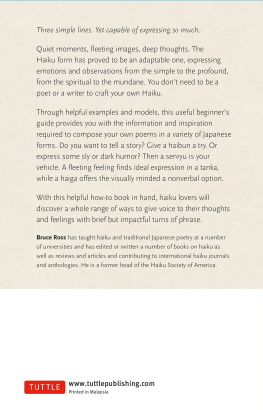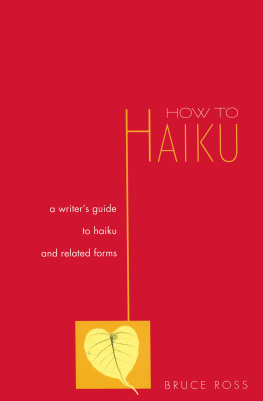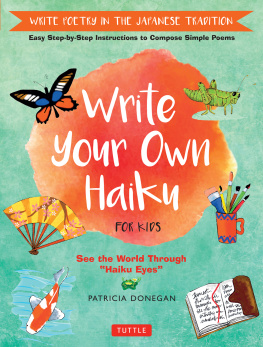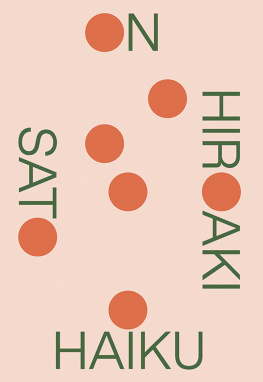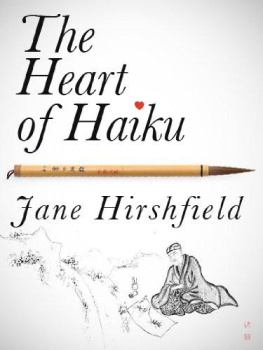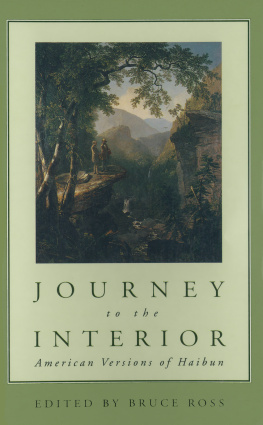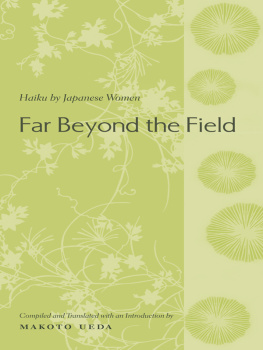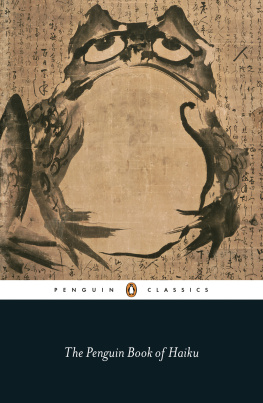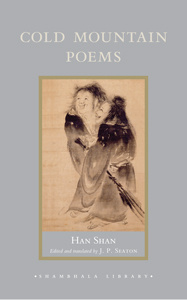Table of Contents
Guide
WRITING
HAIKU
A Beginners Guide to Composing
Japanese Haiku Poetry
Bruce Ross
Contents
To my friends in the world haiku community
A thousand bows to you.
Acknowledgments
I would like to thank my students at Writers & Books, Rochester,
New York; Writers at Champlain Mill, Winooski, Vermont; the
Institute on Japan of the University of Vermont; the Doll-Anstadt
Gallery, Burlington, Vermont; and the Japan-America Society of
Vermont. Also, the comembers of the Haiku Poets of Upstate New
York and the Burlington Haiku Group. And, finally, those haiku po
ets met in activities sponsored by Haiku Canada, the Haiku Society
of America, the Boston Haiku Society, the Kaji Aso Studio, Boston,
Massachusetts, and Haiku North America. Thanks for assistance
are due to Francine Porad, John Stevenson, and Tomiko Hayashi.
Thanks also are due to my editor, Jan Johnson, for nudging me in
the right direction. Lastly, and most importantly, Astrid Calypso
Miriam Andreescu, my wife; Murray David Ross, my brother; and
Tom Clausen, my friend, well deserve very special thanks.
Foreword to the
Second Edition
It has been nineteen years since I published the first edition of
this book. Since then, there have been two major changes in the
haiku world. The first major change is a worldwide interest and
production of haiku in other languages. For example, here is an
award-winning haiku from Goran Gatalica from Croatia, including
the original version in Croatian.
spring pilgrimage
first cherry blossoms
in mothers sandals
proljetno hodoae
prvi cvjetovi trenje
u majinim sandalama
The second major change began in the United States, and represents
a change in phrasing and word choice, perhaps resulting from com
puter and smartphone use.
However, the haiku form is timeless. Each individual haiku poet
has the ability to experience their own so-called haiku moment that
is a poetic insight.
I originally wrote this book as an easy-to-understand guide to
writing haiku and related forms for a young readership. My pub
lisher, Tuttle, wanted a revised edition of the book, but since haiku
is timeless, I have left the body of the book intact.
Bruce Ross, Hampden, Maine 2021
Introduction
ONE EVENING I WAS WATCHING a program about elderly peo
ple who had problems with their bones. As part of their treatment
they joined a class that practiced a form of Tai Chi, the oriental
exercise that has very slow and simple movements and looks like
slow-motion dance. The version for these patients was even simpler.
They stood straight up and moved their arms in a few easy patterns.
In a later interview, one of the patients told how she broke into a
sweat while doing the slow movements as if she had been playing
tennis like she used to. She then commented: Its very difficult to
do something small in a meaningful way.
Haiku is like that. It is perhaps the smallest poetry form in the
world, with about eight to twelve words in three short lines. Yet this
tiny poem can say important things about how we feel about what we
see around us. Haiku was invented hundreds of years ago in Japan.
It was used to express feelings about nature, animals, and the seasons
at a particular time and place and to share those feelings with others.
So to write a haiku means to write about how you feel at a certain
moment in time even if you are writing it down sometime after.
In the spring of 1999 the Burlington Haiku Group set up a
haiku table at the Japan-America Society of Vermonts Japanese
festival. A teenaged boy shrugged his shoulders when I asked him
if he wanted to try writing a haiku. But he sat down and drew an
empty couch to go with this haiku:
nothing happening
just another day
nothing happening
I am sure we have all had one of these days. But we may not have
been able to express this feeling as simply as this boy did. During
that same spring, the childrens librarian of Fletcher Free Library
in Burlington, Vermont, held a haiku writing workshop for kids.
Except for me and some mothers (to act as their childrens scribes),
all those who came to the workshop were kids seven to twelve years
old. One young girl wrote this haiku:
Birds in my backyard
they sing sing sing all day long
birds in my backyard
Another common experience: a bright spring day when the birds
keep up their cheerful singing all day long, colorful spring flowers
all around us. We know what the writer of this haiku felt.
Traditional Japanese haiku has two important parts. One is the
joining of two images where you are really comparing the relation
ship between the two. This comparison is not like those we find in
most poetry. We wouldnt say, He looks like a monkey in a haiku.
Instead, we try to show what our feelings are by putting something
we experienced together with another thing we experienced. We have
a bad day so nothing is happening. Or nothing is happening because
we are having a bad day. Tomorrow will probably be a better day. But
today is a bad day. The other important part of traditional Japanese
haiku is to connect our feelings to nature and the natural seasons.
If we find a snowman, a Halloween costume, spring flowers, or a
sandcastle in a haiku, we know what season that haiku is expressing.
We know how that season feels. So if we find a snowman in a haiku
we remember how winter feels. If birds are singing all day in a hai
ku, we know that it is spring, and we remember how spring feels.
Traditional Japanese haiku and all other haiku can express all
kinds of feelings. Here is a haiku by the Japanese poet who is said
to have created the haiku poem form:
stillness:
sinking into the rocks
a cicadas voice
Basho
We know from Bashos journal that he was traveling around Japan
when he wrote this. In summer he stopped to visit an ancient temple
on a high mountain. This temple was noted for its peacefulness.
Basho wrote that there was absolute silence when he visited and
that he was deeply moved by the experience. His haiku presents
us with his feeling. He first names the silence that is the most
important thing in this experience. The one sound, the crickets
chirp, makes the silence even greater. This small voice is powerful
because it is the only sound. But this small voice is absorbed by
the stillness of the rocks of the mountain and by the silence of the
temple. Compare the kind of feeling in Bashos haiku to one by an
American haiku poet:
Christmas Eve
at the lot, the trees
not chosen
Tom Tico
We all know the happiness of being with our families on Christ
mas Eve. Almost everyone is at home relaxing with a festive meal and
the promise of gifts. We are also supposed to feel goodwill toward
everyone. But for one reason or another some people are left out
of this celebration. The leftover Christmas trees remind us of those
people. This haiku leaves us with a deep feeling of sadness by con
necting this holiday night of expectation, celebration, and reverence
to an image of something left out.
Haiku can also offer a playful feeling. Here is another cricket

